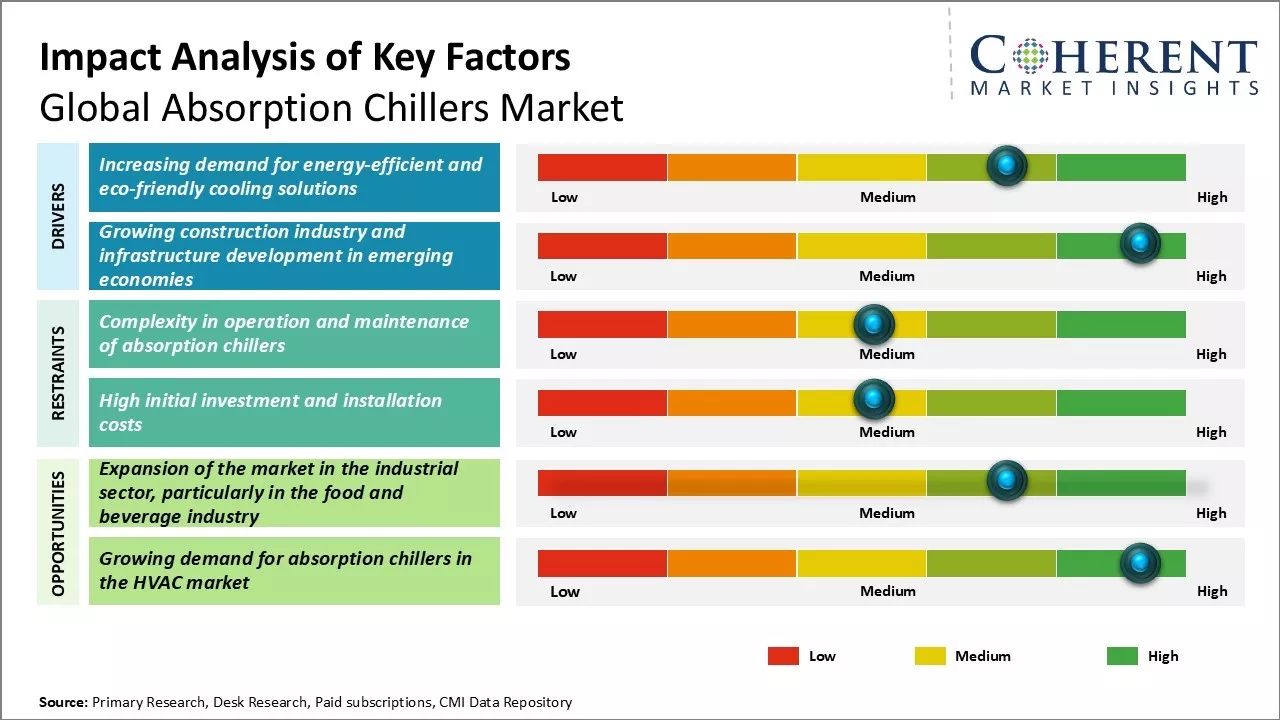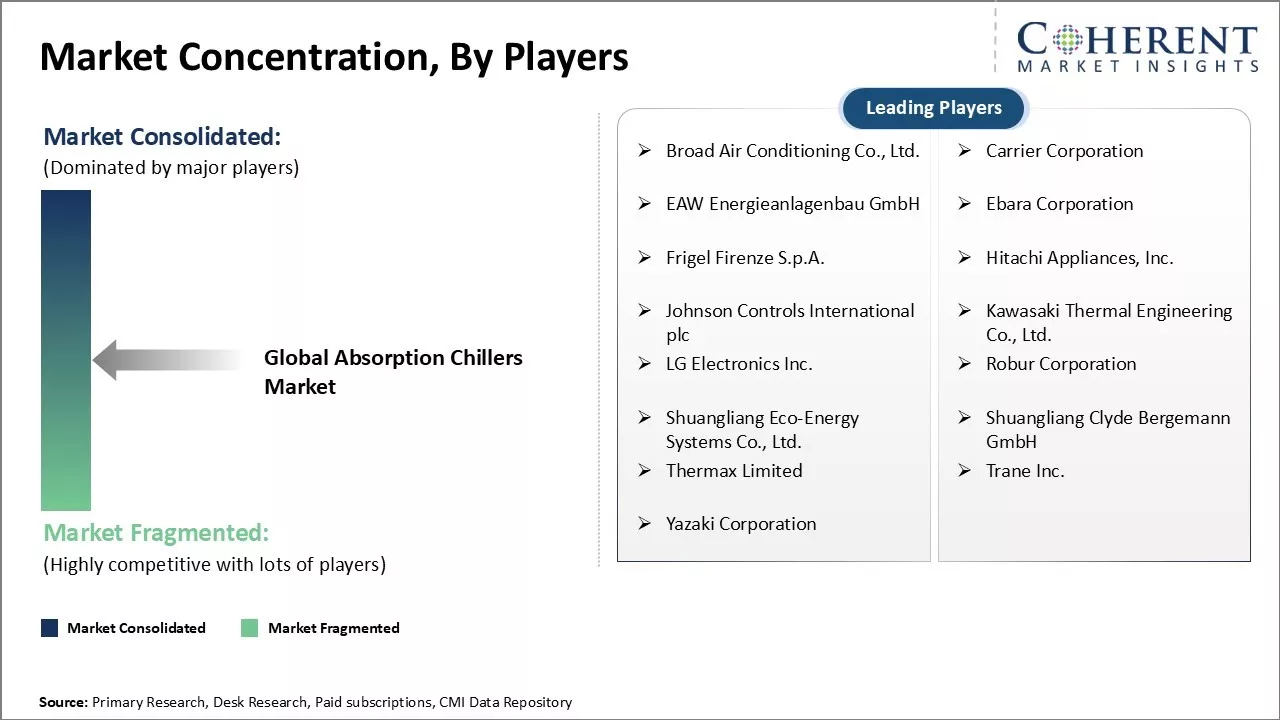The Global Absorption Chillers Market is estimated to be valued at USD 1.50 Billion in 2025 and is expected to reach USD 2.15 Billion by 2032, exhibiting a compound annual growth rate (CAGR) of 5.3% from 2025 to 2032.
The global absorption chillers market is experiencing steady growth, driven by increasing demand for energy-efficient and environmentally sustainable cooling solutions across commercial, industrial, and residential sectors.

To learn more about this report, Download Free Sample
The absorption chillers market is witnessing significant growth owing to the rising focus on sustainable construction and lowering of energy consumption globally. With increasing environmental consciousness and stringent regulations regarding carbon footprint, industries, and commercial establishments are actively looking out for greener alternatives to traditional cooling systems.
Compared to conventional vapor compression chillers that use harmful refrigerants such as HCFCs and HFCs, absorption chillers utilize natural refrigerants like water or ammonia which have negligible global warming potential. Moreover, absorption chillers leverage waste heat or solar energy to drive the refrigeration cycle instead of mechanical work. Their ability to utilize low-grade heat sources such as steam, hot water, or flue gases offers businesses and building owners an ideal way to maximize the utilization of renewable/recovered thermal energy and minimize carbon footprint.

To learn more about this report, Download Free Sample
Artificial intelligence (AI) is revolutionizing the global absorption chillers market by enhancing operational performance, energy efficiency, and product adaptability.
|
Current Events |
Description and its impact |
|
Regulatory Shifts in Refrigerant Policies |
|
|
Energy Security and Pricing Dynamics |
|
Uncover macros and micros vetted on 75+ parameters: Get instant access to report
The rapid urbanization and economic growth in developing nations are fueling a significant demand for absorption chillers in new construction and infrastructure. These regions, often characterized by hot climates, benefit from absorption chillers' durability, low maintenance, and ability to use waste heat, making them ideal for both on-grid and off-grid projects. Their 30-40% lower installation costs and reduced operating expenses, combined with supportive government policies, are attracting developers to this energy-efficient cooling solution. Global manufacturers are actively expanding into these high-growth markets to capitalize on this opportunity.
The industrial sector, especially the food and beverage industry, presents a substantial growth opportunity for absorption chillers. These facilities require extensive and continuous cooling, and absorption chillers offer an attractive solution by utilizing waste heat from their manufacturing processes to power refrigeration. This ability provides a significant advantage over electric alternatives, aligning with growing sustainability goals and carbon reduction efforts in the sector. Customized offerings from manufacturers could further expand their market share within industrial applications.
Thermax, a global leader in energy solutions, has developed customized absorption chiller offerings tailored for food and beverage manufacturers. Their solutions help companies meet sustainability goals by integrating multi-fuel, fully automated heating and cooling systems that optimize energy use.
The global absorption chillers market is seeing significant opportunities driven by increasing demand for sustainable and energy-efficient cooling solutions, especially in the industrial sector and rapidly urbanizing developing nations. These chillers excel at utilizing waste heat, offering a compelling alternative to conventional electric systems.
A Germany-based steel plant, FST Industrie GmbH, reduced energy costs by 20% by installing an absorption chiller that recovers waste heat from its furnaces. Similarly, an India-based cement plant achieved a 15% energy cost reduction by using an absorption chiller to recover heat from kiln exhaust gases.
In terms of product, the single-effect absorption chillers segment is estimated to contribute 46.1% share of the market in 2025 owing to their cost effectiveness and efficiency.
Single-effect absorption chillers require less complex refrigeration process compared to double and triple effect systems. This makes the initial capital cost of single-effect chillers significantly lower. Additionally, the operations and maintenance costs are lower due to less moving parts and simpler design. The efficiency of modern single-effect chillers has improved considerably through technological advancements.
In terms of energy source, the natural gas segment is estimated to dominate the global absorption chillers market with 53.2% share of the market owing to its widespread availability, established distribution infrastructure and competitive pricing.
Most commercial and industrial facilities are already equipped with natural gas pipelines making it convenient to use for absorption chilling systems. Natural gas produces less greenhouse gas emissions than diesel or fuel oil alternatives when used in absorption coolers. It also offers stable and consistent thermal output required for reliable chiller operations. Some regions also provide subsidies or tax incentives for utilizing natural gas over electricity in industrial cooling systems.
In terms of application, the commercial sector segment is estimated to contribute 47.3% share of the market in 2025 owing to exponential growth of commercial real estate in emerging economies.
Rapid urbanization and expansion of services industry has led to construction of large office buildings, retail complexes, hospitals and other commercial establishments worldwide. Proper temperature controls are critical for worker productivity and comfort in commercial facilities. At the same time, rising electricity costs encourage use of alternate technologies like absorption cooling that operate independently of grid supply. Commercial contractors are increasingly selecting absorption chillers to future proof new projects against volatility in energy prices. LEED certified green buildings also push for absorption chilling as it reduces carbon footprint.

To learn more about this report, Download Free Sample
The North America region currently dominates the global absorption chillers market with an estimated 37.2% share in 2025. The large-scale presence of various industries such as commercial buildings, hospitals, hotels, and manufacturing facilities is driving significant demand for absorption chillers in the region.
Stringent regulations regarding energy usage and carbon emissions are compelling building owners and facility managers to replace outdated HVAC systems with more energy-efficient absorption chillers.
The Asia Pacific region has emerged as the fastest-growing market for absorption chillers globally. Rapid urbanization and industrialization are leading to increased construction of large commercial buildings and manufacturing plants across countries such as China, India, and Southeast Asian nations.
Moreover, governments of developing nations are focusing on strengthening their domestic manufacturing industries through various incentives and policies. Many local absorption chiller manufacturers are leveraging on these supportive conditions to increase their production volumes and cater to the rising installation needs. The relatively lower manufacturing and material costs compared to North America and Europe are making Asian absorption chillers more price competitive in their home markets as well as export destinations. This is expected to propel the Asia Pacific region to the forefront of the global absorption chillers industry over the coming years.
The U.S. accounts for the majority of the North American market owing to the size of its commercial real estate and manufacturing industries. Additionally, growing awareness about the financial and environmental benefits of absorption chillers is encouraging new installations, especially in the hospitality and healthcare sectors.
Several state and local governments offer rebates and tax incentives for adopting renewable energy-based cooling solutions like absorption chillers. This is further boosting their popularity and consolidating the North American leadership in the global market.
India Absorption Chillers Market is growing due to rapid urbanization, increased construction, and a strong push for energy-efficient and sustainable cooling solutions, particularly benefiting from the ability of absorption chillers to use waste heat. This trend is further supported by government initiatives promoting green financing and environmental compliance, making absorption chillers an attractive investment for developers across India.
| Report Coverage | Details | ||
|---|---|---|---|
| Base Year: | 2024 | Market Size in 2025: | USD 1.50 Bn |
| Historical Data for: | 2020 To 2024 | Forecast Period: | 2025 To 2032 |
| Forecast Period 2025 to 2032 CAGR: | 5.3% | 2032 Value Projection: | USD 2.15 Bn |
| Geographies covered: |
|
||
| Segments covered: |
|
||
| Companies covered: |
Broad Air Conditioning Co., Ltd., Carrier Corporation, EAW Energieanlagenbau GmbH, Ebara Corporation, Frigel Firenze S.p.A., Hitachi Appliances, Inc., Johnson Controls International plc, Kawasaki Thermal Engineering Co., Ltd., LG Electronics Inc., Robur Corporation, Shuangliang Eco-Energy Systems Co., Ltd., Shuangliang Clyde Bergemann GmbH, Thermax Limited, Trane Inc., and Yazaki Corporation |
||
| Growth Drivers: |
|
||
| Restraints & Challenges: |
|
||
Uncover macros and micros vetted on 75+ parameters: Get instant access to report
Share
Share
About Author
Ramprasad Bhute is a Senior Research Consultant with over 6 years of experience in market research and business consulting. He manages consulting and market research projects centered on go-to-market strategy, opportunity analysis, competitive landscape, and market size estimation and forecasting. He also advises clients on identifying and targeting absolute opportunities to penetrate untapped markets.
Missing comfort of reading report in your local language? Find your preferred language :
Transform your Strategy with Exclusive Trending Reports :
Frequently Asked Questions
Joining thousands of companies around the world committed to making the Excellent Business Solutions.
View All Our Clients